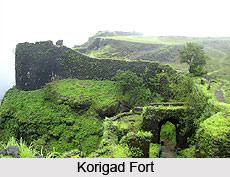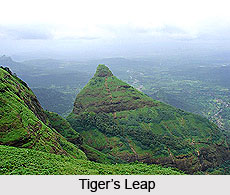 Tourism in Khandala, Maharashtra comprise of several places that dazzle the visitors with its spectacular scenery, verdant hills, deep green valleys, beautiful lakes and waterfall and draws all the tourists seeking serenity from routine works of the day-to-day living. This hilly place is located in the Sahyadri Mountains and is 5 km away from Lonavala, yet another popular hill getaway. Situated at an altitude of 625 m, this quiet hill town is a weekend escape for residents of Mumbai and Pune.
Tourism in Khandala, Maharashtra comprise of several places that dazzle the visitors with its spectacular scenery, verdant hills, deep green valleys, beautiful lakes and waterfall and draws all the tourists seeking serenity from routine works of the day-to-day living. This hilly place is located in the Sahyadri Mountains and is 5 km away from Lonavala, yet another popular hill getaway. Situated at an altitude of 625 m, this quiet hill town is a weekend escape for residents of Mumbai and Pune.
Places of Tourist Interest in Khandala
Though the origin of Khandala is enshrouded in obscurity, the history says that this hill resort was the part of the territory of the great Maratha leader Chattrapati Shivaji, who is credited with organizing the Maratha into a military power. Later it came under the rule of the Peshwa, during whole reign Maratha power reached its zenith. Khandala was taken by the British from the hands of the Peshwas who subsequently lost power to the British.
Nature tourism in Khandala
Among some other places of interest the name of Rajmachi Park can be mentioned. It falls on the way to Mumbai from Lonavala before the beginning of the Ghat. A spectacular garden with an assemblage of majestic tall trees that attracts the tourists is Ryewood which is located near Lonavala. In addition to these places, there are some nearby places that worth visiting such as Lonavala Lake, Tugauli Lake and Bhushi Lake and Walvan Dam near Khandala. Moreover, Satayam Shivam Sundaram Waterfall, a gorgeous man-made waterfall, is a very popular spot of vacationers. Dukes Nose and Tiger`s Leap are also popular amongst the visitors.
Leisure tourism in Khandala
There are several historical spots that are sure to engage the attention of the visitors. Lohagad Fort is one such tourist place. Lohagad Fort is located very near from Khandala has few magnificent-looking entrance gates and a water tank
 . The Amruntanjan point at the Khandala, Karla and Bhaja Caves of Khandala are the major attractions of this place. With an amazing view of the surroundings, from the east side two towers of the Rajmachi Fort can be seen with a huge valley at the bottom. Apart from these, Khandala has places like Tunga Fort surrounded by the Pavana Dam and has an old Hindu Mahadeo temple within its precincts. The Kaivalya Dham Yoga Centre of Khandala offers yoga classes and this institute is popular for providing necessary health tips and proper way of practicing yoga asanas. The tourism of Khandala enables the visitors to indulge in trekking of the hilly area.
. The Amruntanjan point at the Khandala, Karla and Bhaja Caves of Khandala are the major attractions of this place. With an amazing view of the surroundings, from the east side two towers of the Rajmachi Fort can be seen with a huge valley at the bottom. Apart from these, Khandala has places like Tunga Fort surrounded by the Pavana Dam and has an old Hindu Mahadeo temple within its precincts. The Kaivalya Dham Yoga Centre of Khandala offers yoga classes and this institute is popular for providing necessary health tips and proper way of practicing yoga asanas. The tourism of Khandala enables the visitors to indulge in trekking of the hilly area.
Visiting Information on Khandala
The tourism in Khandala offers to shop the famous fast food of the place like `chikkis`, jams, `chiwda`, wafers and various types of `sevs`. Other places of interest that lie near Khandala include Panchgani, Raigad, Mahabaleshwar, Satara, Pune, Lavasa, Chiplun and Kamshet.
Accommodations in Khandala
Tourism in Khandala encompasses the impressive hotel facilities as well. There are some popular 3 Star hotels that cater to the needs of a large number of visitors who throng this beautiful hill station, the names of Fun-N-Food, Girija Hotel Hotel-La-Revival, Mount View Resort, The Dukes Retreat and Velvet Hills Retreat are some premium hotels of Khandala. The visitors get optimum level of satisfaction from these Hotels in Khandala as they provide state of the art accommodation, a fine dining experience and a host of other facilities at a reasonable rate. Moreover, the Budget Hotels in Khandala offers simple but clean and spacious living quarters at a fairish rate. On the other hand one can also have provision for Luxury Hotels in Khandala that provides with state of the art conference facilities, exclusive eateries, coffee shops, a host of recreation facilities and most importantly customer centric services. The interiors of these hotels have been crafted and designed with much care keeping an eye to comfort and elegance. Some of them are at par with international standard of hospitality and customer centric services.
How to Reach Khandala
•Air The nearest airport from Khandala is Pune, which is 65 kms from Lonavala and Airports of Mumbai is about 101 kms away.

•Rail In case of train, Khandala falls on the main railway line between Mumbai and Pune, all express trains plying between the two cities stop here. Another means can be bus journey that takes 2hrs from Pune and roughly 4 hrs from Mumbai.
•Road There are also buses plying between Lonavala and Khandala, about 15 minutes ride between the points.
The tourism in Khandala allows the visitors to enjoy the scenic beauty with savouring the adventure of the place. The travelers who come to enjoy a short trip can stopover this place to take a refuge from the tight schedule of their hectic life.



















